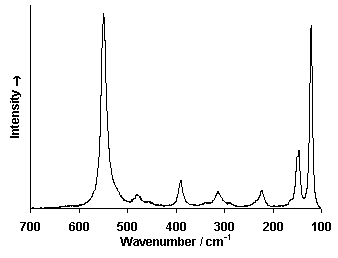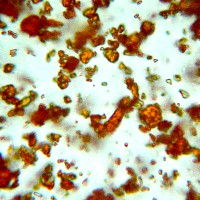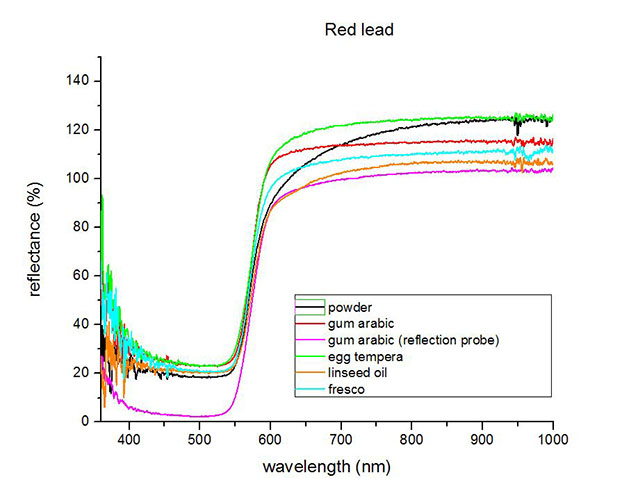Red Lead
Artificial inorganic pigmentComposition and Properties of Red Lead
It is a mixed lead oxide containing Pb2+ and Pb4+ lead ions with an overall formula of Pb3O4. The pigment has been artificially prepared since antiquity but can also be found in nature as the mineral minium.
The pigment is soluble in diluted acids, it cannot be used in fresco and in watercolor and it can blacken after prolonged exposure to air. It is not compatible with orpiment.

Pigment

Painted swatch

Powdered pigment
Image courtesy of Technisches Museum Wien
Names of Red Lead
Alternative names
Minium, Saturn red, Paris red, minium
During the Roman Empire, the term minium could refer either to the pigment made from ground cinnabar or to the less expensive red lead.
Color Index
PR 105, CI 77578
Word origin
Minium was named for the Iberian river known to the imperial Romans as Minius, now known as the Spanish Miño and the Portuguese Minho located near the main Roman cinnabar mines on the Spanish-Portuguese border.
From WordFinder
Mennige
German
Minium
French
Minio
Italian
Minio
Spanish
Preparation of Red Lead
Red lead can be prepared by heating lead (II) oxide in the air at about 450° C. It was also prepared by heating lead white (basic lead carbonate) in air.
Minium is a naturally occurring mineral of the same composition.
References
Paula M. Gonçalves, João Pires, Ana P. Carvalho, Maria Helena Mendonça, António João Cruz, “Theory vs practice: synthesis of red lead following ancient recipes“, in Luís Urbano Afonso (ed.), The Materials of the Image. As Matérias da Imagem, Lisboa, Cátedra de Estudos Sefarditas «Alberto Benveniste» da Universidade de Lisboa, 2010.
History of Use
The pigment has been in use since antiquity until around the nineteenth century. The following graph gives the frequency of its use from the 14th until the 19th century in the paintings of the Schack Collection in the Bavarian State Art Collections in Munich (1).

References
(1) Kühn, H., Die Pigmente in den Gemälden der Schack-Galerie, in: Bayerische Staatsgemäldesammlungen (Ed.) Schack-Galerie (Gemäldekataloge Bd. II), München 1969.
Example of use
Albrecht Dürer, Virgin with Child and St Anna, 1519

Identification
Fiber Optics Reflectance Spectrum (FORS)
FORS spectrum by A. Cosentino, Cultural Heritage Science Open Source (CHSOS)
Infrared Spectrum

IR Spectrum of the pigment in linseed oil by S. Vahur, Database of ATR-IR spectra of materials related to paints and coatings, University of Tartu, Estonia
IR Spectrum of the pigment in the ATR-FT-IR spectra of different pure inorganic pigments, University of Tartu, Estonia.
Raman Spectrum

Spectrum by Ian M. Bell, Robin J.H. Clark and Peter J. Gibbs, Raman Spectroscopic Library
University College of London
References
Howell G. M. Edwards, Dennis W. Farwell, Emma M. Newton and Fernando Rull Perez, Minium; FT-Raman non-destructive analysis applied to a historical controversy, Analyst, 9, 1999.
X-Ray Fluorescence Spektrum (XRF)
XRF Spectrum in the Free XRF Spectroscopy Database of Pigments Checker, CHSOS website.

Microphotograph
image © Volker Emrath
Further Reading
References
(1) E. W. Fitzhugh, Red Lead and Minium, in Artists’ Pigments. A Handbook of Their History and Characteristics, Vol. 1: Feller, R.L. (Ed.) Oxford University Press 1986, p. 65 – 108. Available as pdf from the National Gallery of Art.
(2) Dunn, E.J. Red Lead, in Pigment Handbook, vol.1, ed. T.C. Patton, New York 1973, p. 837-42.
(3) S. Muntwyler, J. Lipscher, HP. Schneider, Das Farbenbuch, 2nd. Ed., 2023, alataverlag Elsau, pp. 78-79 and 360-367.















